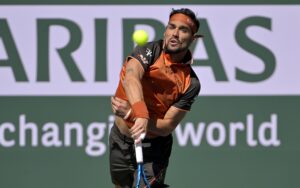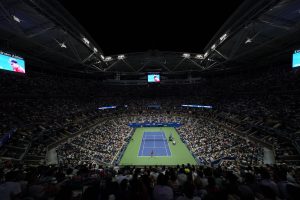In our increasingly speeded-up 21st century, it often seems that everything is new. Apparently, orange is the new black, tech is the new rock and roll, and thirty is the new forty. But such is the rate of change that perhaps the new is itself being replaced by the old, so much so that perhaps old is the new new. And nowhere is that more evident than in the world of sport in general and the world of tennis in particular.
The announcement this week that Roger Federer has signed a three-year deal to play in his hometown tournament, the Swiss Indoors event in Basel, was confirmation that the “GOAT” (greatest of all time) is nowhere near being put out to pasture. Federer will be 38 by the time he plays in the 2019 version of the Basel event, which will be more than 20 years after he first appeared in it, losing as an obviously gifted but callow 17-year-old to Andre Agassi in 1998.
Of course, this development continues the dominant theme of this year’s Australian Open, when 2017 seemed an awful lot like 2007, as Federer faced Nadal in the men’s final and the Williams sisters contested the women’s final. These four truly great players, with an astonishing 62 Grand Slam singles titles between them, proved conclusively that tennis is no longer the young man’s or young woman’s game that it has been thought of for much of its history.
In winning so spectacularly in Melbourne, finally defeating his nemesis Nadal in a Major final for the first time in a decade, Federer became the second oldest man in the Open era to win a Grand Slam singles title, after Ken Rosewall, who won the 1972 Australian Open at the age of 37. And Serena Williams has been even more impressive in what would have been traditionally thought of as her dotage (at least in playing terms), by winning nearly half (10 out of 23) of her new Open era record of Grand Slam titles after she turned 30.
This is in contrast to most of the Open era, when the new age of professionalism (or rather overt professionalism, as opposed to the “shamateurism” that preceded the arrival of the Open era in 1968) arrived. Few of the truly great players of either gender maintained their greatness into their late thirties, or indeed even into their mid thirties. Rod Laver was only 31 when he won his last Major title, the 1968 US Open, with which he sealed his second calendar Grand Slam; Pete Sampras was the same age when he won his last Major in 2002, again at the US Open; and most famously, Bjorn Borg and John McEnroe, who enjoyed the greatest rivalry in tennis before Federer-Nadal, won their final Grand Slam titles when they were only 24 and 25, respectively. Things were a little better for the “oldies” in the women’s game, with Margaret Court, Billie Jean King, and Martina Navratilova all winning Majors in their thirties, but they were still regarded as the exceptions to the rule–the rule being that tennis players, like all sportsmen and women, were at their best before they turned thirty.
That rule may no longer apply, not only in tennis but in sport in general. Within a week of Federer definitively proving himself to be the finest male tennis player ever (statistically as well as aesthetically), Tom Brady was achieving a similarly improbable comeback, and similarly unmatchable greatness in his sport, by winning Super Bowl LI, less than six months before his 40th birthday. And just as Federer has now committed himself to playing on at least until he is 38, so Brady has pledged to continue playing American football well into his forties.
Of course, this is all part of a much wider trend in overall human development, as most of humanity is gradually getting fitter and living longer, as was confirmed in another news item this week, when it was announced that South Korean women will shortly be living to an average age of 90, the first time in human history that that particular milestone has been achieved. (How long will it be before another country reaches an average life expectancy of a hundred?) It is in this context that it is perhaps not so surprising that the very finest physical specimens – the greatest professional sportsmen and women, like Federer, Serena Williams and Tom Brady – should be so dramatically extending their careers into previously uncharted territory.
What this means for sporting history in general and tennis history in particular is yet to be determined, but it is at least arguable that the likes of Federer and Brady will go on to set records that may never be beaten, or at least not for a very long time, especially if they go on to extend their domination of their chosen sport. They certainly hope to, with Federer, fresh from his Aussie Open triumph, realistically eyeing up future Grand Slam wins, especially on his favored faster courts at Wimbledon and the US Open, and Brady greedily contemplating filling a second hand with Super Bowl rings. Certainly, Andy Roddick, who is shaping up to match John McEnroe in being an even better commentator on tennis than he was a player, thinks that Federer’s current record total of 18 may well stand for decades if his great rivals of this era, Nadal and Djokovic, cannot break it.
One of the finest French proverbs, so fine that it has passed into universal usage, is, “If the young only knew, if the old only could,” conveying the idea that the young lack wisdom and the old lack energy. Now, at the dawn of a new century, when mankind itself (sort of) celebrates its 21st birthday and supposedly comes of age, it is finally feasible that some members of our species can couple the irrepressible energy of the young with the hard-won wisdom of the old (or at least the middle-aged). If that is the case, there is every chance that Melbourne 2017 was not a fascinating one-off but the genuine beginning of a new era.






